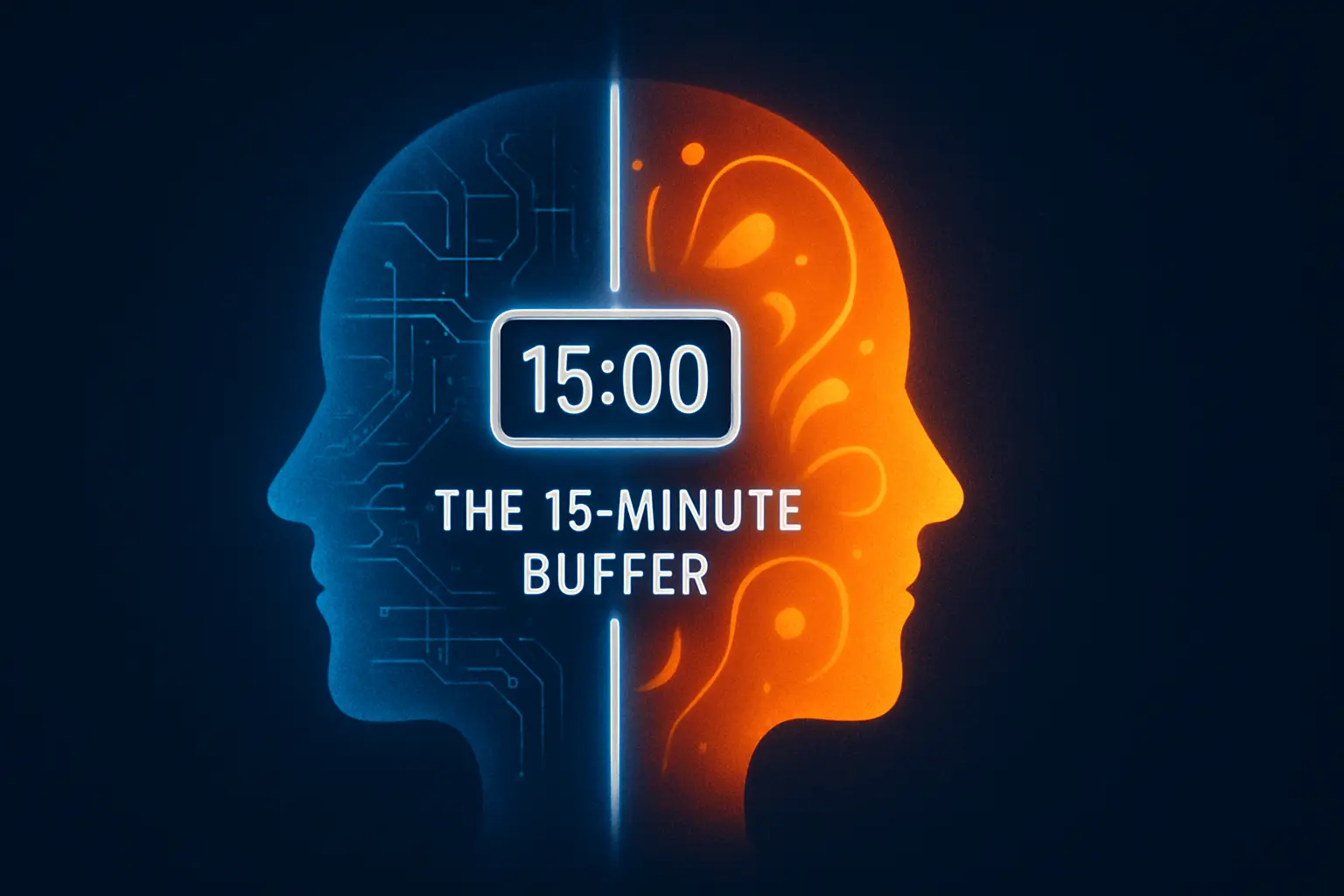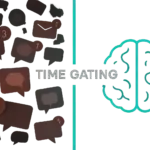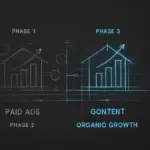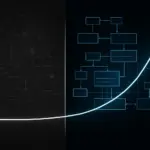The 15-Minute ‚Context-Switching‘ Ritual That Unlocks Hours of Deep Work
It’s 10:59 AM. I’ve just spent two hours deep in a technical review for a new solar module production line at JvG Technology. We were dissecting automation sequences, PLC logic, and robotic arm tolerances—work that requires intense, granular focus. My calendar alert chimes. At 11:15 AM, I have a strategy call for Iberosattel to brainstorm a new content marketing campaign for our premium saddles.
In the past, that 15-minute gap was a recipe for mental whiplash. My brain would still be debugging a production line even as I tried to switch gears to customer personas and creative storytelling. The first ten minutes of the marketing call would be lost while I struggled to catch up, my focus still tethered to the previous task.
This lingering effect has a name: ‚attention residue.‘ Professor Sophie Leroy’s research at the University of Washington found that when we switch tasks, part of our attention stays stuck on the one we just left. This residue sabotages our performance on the new task. For a founder or operator juggling vastly different contexts, this isn’t a minor inconvenience—it’s a serious drag on effectiveness.
I realized I couldn’t just power through it. I needed a system—a deliberate, repeatable process to manage the transition itself. So I developed a 15-minute ‚buffer ritual‘ that I now run between vastly different blocks of work. This isn’t about taking a break; it’s about a controlled shutdown of one context and a deliberate start-up for the next.
The Hidden Cost of Jumping Between Worlds
Before I break down the system, it’s worth understanding the cognitive tax we pay for context switching. We tend to see the time on our calendar as clean, transferable blocks, but our brains simply don’t work that way.
The American Psychological Association estimates that switching between tasks can cost as much as 40% of our productive time. Think about that. For every eight-hour workday, that’s potentially three hours lost to the mental friction of changing gears. And it isn’t just about time; it’s about the quality of our focus.
A study from the University of California, Irvine, found it takes an average of 23 minutes and 15 seconds to get back to a task after an interruption. When we jump from meeting to meeting without a buffer, we are essentially self-interrupting. We show up to the next meeting operating at a fraction of our cognitive capacity, our attention still fragmented.
This isn’t a personal failing; it’s a biological reality. My goal wasn’t to eliminate context switching—it’s an inherent part of my work—but to manage its cost. This ritual is my system for accelerating that 23-minute refocusing period into a controlled, 15-minute transition.
Building a Buffer: My 15-Minute Context-Switching System
I treat this 15-minute block as a non-negotiable part of my schedule. The ritual has three distinct phases, each designed to tackle a specific part of the cognitive load.
Phase 1: The Shutdown (5 minutes)
The first step is to give my brain explicit permission to close the previous task. This creates a clean exit, minimizing attention residue.
-
Document & Close (3 mins): I open a simple text file or my notebook to write down two things: a one-sentence summary of what was accomplished, and the single most immediate next action for that project. For the JvG meeting, it might be: ‚Next step: Email the robotics supplier with the revised tolerance specs.‘ This simple act counters the Zeigarnik effect—our brain’s tendency to obsess over unfinished tasks. By defining the next step, I’ve ’saved my progress,‘ making it easier for my mind to let go. Then, I close every related tab, window, and application.
-
Physical Disconnect (2 mins): I stand up, walk away from my desk, and get a glass of water. The physical state change is a powerful signal to my brain that the context has shifted. I’m no longer in the ‚JvG engineering‘ space; I’m in a neutral one.
Phase 2: The Neutral Zone (5 minutes)
This is the most critical and counter-intuitive phase. The goal here is not to think about the next task. It’s to create a mental palate cleanser—a moment of intentional emptiness to allow the cognitive dust to settle.
During these five minutes, I do absolutely nothing ‚productive.‘ I might stare out the window, listen to a single instrumental track without lyrics, or do a simple 60-second box breathing exercise. The key is to resist the urge to check email, scroll through Slack, or glance at my phone. Those activities are not breaks; they are micro-context switches that defeat the entire purpose. This clears the cognitive cache.
A person’s hands are shown writing in a notebook on a clean, wooden desk. A laptop and a cup of coffee are nearby, suggesting a moment of focused planning and reflection.
Phase 3: The Ramp-Up (5 minutes)
With a clearer mind, I can now intentionally prime my brain for the upcoming task. I don’t just open the Zoom link and dive in.
-
Prime the Context (4 mins): I open the one key document for the next meeting. For the Iberosattel strategy call, this might be the agenda, the latest sales figures, or a customer persona document. I spend a few minutes simply re-reading it, letting the language, goals, and context soak in. This step pre-loads the necessary information, so I enter the meeting already up to speed. It’s a practice that aligns with the core ideas of designing scalable business systems, where proper preparation is fundamental to efficient execution.
-
Define the Objective (1 min): I write down one sentence at the top of my notes for the meeting: ‚My primary goal here is to…‘ For the marketing call, it might be: ‚…define three potential angles for the Q4 content campaign.‘ This provides immediate focus and direction, so I enter the conversation with intent.
Why This System Works (and Isn’t Just a ‚Break‘)
This ritual isn’t about relaxation; it’s a strategic cognitive reset. It’s a micro-system that acknowledges how our brains actually work, rather than forcing them into an inefficient, brute-force mode.
- The Shutdown phase directly combats attention residue.
- The Neutral Zone allows for cognitive recovery, preventing the 40% productivity loss.
- The Ramp-Up phase proactively builds focus, drastically shortening the 23-minute re-engagement delay.
Patrick Thoma stands in front of a large whiteboard covered in diagrams and notes, pointing to a specific part of a system map. This image conveys strategic thinking and the process of building complex systems.
This intentional, structured approach has been transformative. The quality of my contributions in back-to-back meetings has improved because I show up fully present. It’s a small-scale implementation of the same principles I apply in our company-wide weekly project review process—structure and intention lead to clarity and better outcomes.
Frequently Asked Questions (FAQ)
What if I don’t have a full 15 minutes?
The principle matters more than the exact timing. If you only have five minutes, scale it down: 2 minutes for Shutdown (document next step, close tabs), 1 minute for Neutral Zone (stand up, deep breath), and 2 minutes for Ramp-Up (scan the single most important document for the upcoming task). A 5-minute structured buffer is infinitely better than a zero-minute chaotic jump.
Does this work for switching between small tasks?
This system is designed for transitions between blocks of deep work or significant meetings. For smaller, administrative tasks (like clearing an inbox or updating a spreadsheet), I find task batching is a more effective system. I group all similar small tasks and execute them in one dedicated block to avoid the switching cost altogether.
Can I use my phone during the ‚Neutral Zone‘?
I strongly advise against it. Your phone is a context-switching engine. Opening it, even for a moment, invites dozens of potential new contexts (emails, news alerts, messages) that pollute the neutral zone. The goal is a mental reset, not the introduction of a third, fourth, or fifth context.
How do I remember to do this?
I schedule it directly into my calendar. Between any two significant, back-to-back meetings, I have a recurring 15-minute event labeled ‚Context Buffer.‘ By making it a formal part of my schedule, it becomes a protected, non-negotiable part of my workflow.
From Whiplash to Intentional Shifts
Context switching is an unavoidable reality for anyone leading projects or businesses. But the mental fatigue, lost productivity, and drop in decision quality don’t have to be inevitable. By treating the transition between tasks as a system to be designed and optimized, we can move from feeling reactive and fragmented to being focused and intentional.
This 15-minute ritual has become one of the most valuable systems in my personal productivity toolkit. It’s a small investment of time that pays massive dividends in clarity and effectiveness throughout the day.
If you’re exploring how to apply systems thinking to broader business challenges, my notes on building an automation-first culture extend this same logic of intentional design to an entire organization.




